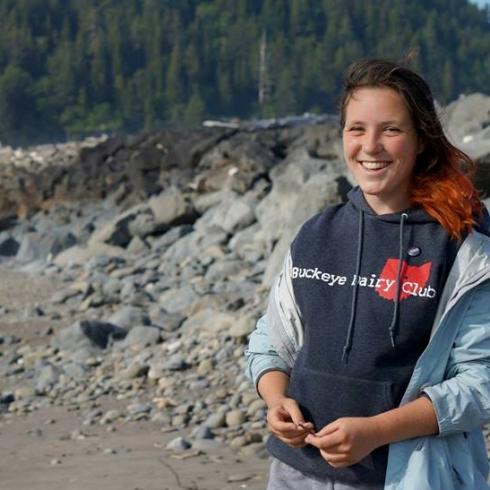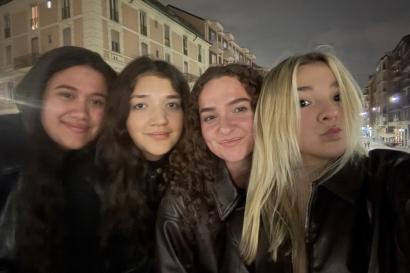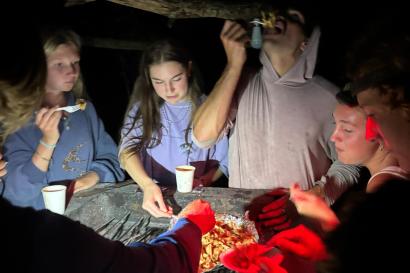On Monday we took a field trip to two non-profits in the highlands of San Cristóbal. Both organizations were run by passionate, energetic, dedicated individuals… but were they really getting the right things accomplished?
Our first stop was an organic farm. The exuberant owner, Marcus, explained the plastic greenhouse coverings and the farm’s humble beginnings. Vegetable cultivation is new to the Galápagos, since most settlers used to range cattle and now live in town. Marcus watched YouTube videos to learn everything he knows, from planting tomato seeds to creating his own organic fertilizer from the municipal waste stream. One student asked how the plants are pollinated in the sealed greenhouse. “I don’t know,” he replied, “I’ll have to check Wikipedia!”

Marcus stands behind the pile of dirt we are about to mix by hand.
First, we used our hands to mix an assortment of moldy-smelling liquids into a pile of dirt. “The dirt is rich and fertile – the perfect organic fertilizer,” he told us.
“Where does the dirt come from?” I asked.
“Outside.”
I can’t imagine that pulling soil from the backyard forest is sustainable, but it works for now.

Here I am mixing some organic mystery sludge to add to the dirt. (Photo credit Addy Borges.)
Then it was planting time. We hoed rows, enriched the soil with handfuls of lime and earth, and planted hundreds of pepper seedlings. A single assistant farmer dispensed seedlings one at a time, creating a giant bottleneck. A few of us were earnestly trying to be productive – hoeing additional rows, harvesting beans from another part of the greenhouse – but most of us gave in to the Ecuadorian don’t-get-anything-done-too-quickly mindset.

Nikki hoes a row with enthusiasm. (Photo credit Addy Borges.)

Three gringas plant pepper seedlings in lime dusty, fertilized dirt. (Photo credit Addy Borges.)
When we were done, I looked around at fifteen gringos in skinny jeans or zip-off hiking pants standing around three rows of wilty seedlings. “Are we actually helping you guys?” I asked Marcus.
“Oh yes,” he answered. “You just accomplished in half an hour what would normally take me and two other workers two full days.”
Imagine what we could have done with two seedling dispensers!
Next came the fun part: harvesting peppers, shelling purple-spotted pinto beans, and ripping down expired plants. We love getting dirty.

Nobody wanted to stop shelling beans when it was time to leave.
I found the organic farm fascinating. At the same time, I was a dubious about vegetable farming on the Galápagos. These islands are home to hundreds of endemic species, the last semi-pristine islands left on Earth. Agriculture has already destroyed much of the islands’ humid zone and introduced countless invasive species – so shouldn’t we try to eliminate farming from the islands and import food instead?
At the farm, I learned the situation is more complex than that. Cargo ships, especially those containing fresh produce, risk bringing new invasive species to the islands, so growing a selection of fruits and vegetables on the islands could significantly reduce that risk. However, Marcus’s ultimate goal of exporting vegetables to the mainland as a new economic market just doesn’t make sense. For the sake of conservation, I would rather see ecotourism remain the base of the islands’ economy.
After farming, we ate lunch at a non-profit called Jatun Sacha.

A mural at the entrance to Jatun Sacha.
Jatun Sacha owns a few hundred hectares of transition-zone forest. They employ about twenty short-term volunteers at any given time. Each volunteer pays $30 a day for the privilege of yanking out raspberries, planting scalesia trees in neighboring farms, and laying National Park paths under the baking sun. When I was there, most of the volunteers were German girls taking a gap year after high school.
Jatun Sacha’s stated mission is reforestation, but volunteer education seems like the main focus to me. One of their more successful projects has been convincing neighboring coffee farms to plant native scalesia as shade trees rather than invasives like Spanish cedar and common guava.

Our guide, Cesar, shows us a native scalesia tree on the Jatun Sacha grounds.

A mural on the classroom wall provides both decoration and a lesson in leaf morphology.
My time at Jatun Sacha got me thinking about what sort of work would really make a difference in Galápagos conservation. Our guide, Cesar, explained that a huge problem in San Cristóbal’s agricultural zone is that farmers have abandoned their land to work in town, giving invasives like guava the chance to take over former pastures.
But wait, isn’t abandoned land a great opportunity? The Galápagos are technically 97% National Park, but nearly all the protected land is located in the arid zone. The higher, humid region (comprised of the transition, scalesia, brown, and fern-sedge vegetation zones) has been almost entirely destroyed by agriculture on San Cristóbal and Santa Cruz. If property value in this zone is so low that farms are abandoned, I see huge potential for conservation. The National Park could purchase abandoned farms from their owners for a reasonable sum – not too expensive for the Park, a pleasant bonus for the townspeople – and return them over time to native vegetation.
The organic farm and Jatun Sacha might not be saving the entire humid zone, but they got me thinking. The hard-working farmers and volunteers we met are doing their best to protect the unique flora of the Galápagos. I hope it will be enough.

Nina Finley
<p><span style="color: rgb(29, 29, 29); font-family: Arial, Verdana, sans-serif; font-size: 12px; line-height: normal; background-color: rgb(237, 237, 237);">Nina Finley is a sophomore at The Ohio State University. She ventured to the Midwest from her hometown of Seattle, Washington to major in Animal Sciences and Evolution & Ecology. She would like to become a livestock vet or marine biologist. When she’s not studying, Nina loves to play ultimate frisbee, watch birds and raise meat rabbits. She’s passionate about agriculture, nature and Spanish, all of which she hopes to explore in Ecuador. Join the journey as Nina traces Darwin’s path and explores the natural wonders of the Galapagos Islands!</span></p>







